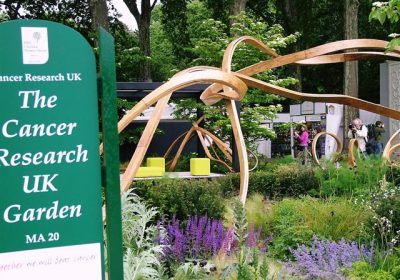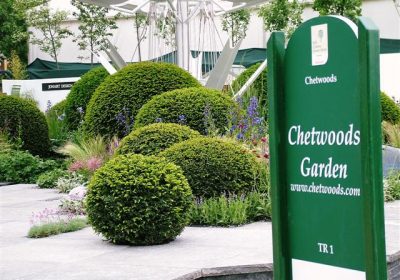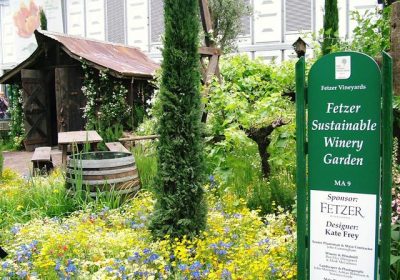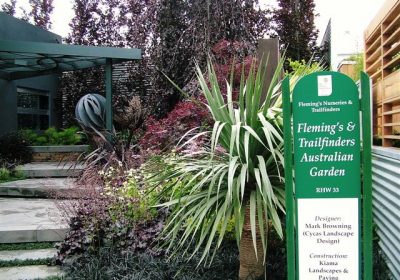Lifelong Learning Chelsea 2007
Description
Association of British Fungus Groups
Fungus is not the bogeyman!
Site number: GPG20
Contact: Michael Jordan
Tel: 01460 221 788
Email: [email protected]
www.abfg.org
Address: Harveys, Alston, Axminster, Devon EX13 7LG
Fungus is not the bogeyman!
Site number: GPG20
Contact: Michael Jordan
Tel: 01460 221 788
Email: [email protected]
www.abfg.org
Address: Harveys, Alston, Axminster, Devon EX13 7LG
Mycorrhiza is something of a buzzword in horticulture and this exhibit focuses on the positive and beneficial links between certain fungi and green plants. The emphasis in the display is on symbiosis with trees that may readily be grown in the garden. Fungi that in this way are of direct benefit in the garden become the ‘stars’ of the exhibit.
The display includes a new range of life-like models of 25 mycorrhizal fungi species that have established symbiotic links with native trees including beech, English oak, weeping birch, Scots pine, European larch and spruce.
British Beekeepers’ Association
Urban Beekeping
Site number: GPG9
Contact: Christine Gray
Tel: 01462 450707/07891 000207
Email: [email protected]
www.britishbeekeepers.com
Address: 47 West Hill Hitchin Herts SG5 2HY
Urban Beekeping
Site number: GPG9
Contact: Christine Gray
Tel: 01462 450707/07891 000207
Email: [email protected]
www.britishbeekeepers.com
Address: 47 West Hill Hitchin Herts SG5 2HY
This exhibit is a roof garden that could belong to a city beekeeper and that shows visitors how bees can be kept safely in an urban environment. The garden shows how bees can thrive in an urban environment as they have the advantage of a massive range of trees and garden plants on the doorstep, far wider than would be found in today’s monoculture countryside. Bees can find nectar everywhere in the city; from street trees to railway embankments.
The roof terrace is filled with fruit and flowers growing in planters and smaller containers. The organisers also hope to include espaliered fruit trees that would benefit from bee pollination, plus a selection of bee friendly plants such as lavenders and wallflowers. On one side of the exhibit is a beekeeper’s shed with rows of different types of honey, glowing like treasure. On the floor of the shed is beekeeping equipment including bee veils, smokers and hive tools. In the centre of the terrace is a table with partially assembled frames by the beehive. At the front of the display are two hives. One of these is a display hive and the other a complete hive, with frames of honey in the top so that people can look inside and smell the honey.
The display’s organisers, Philippa O’Brien and Melanie Whitlock, took up beekeeping a year ago and have since been entranced by it. Philippa keeps bees in her small town garden in Hammersmith while Melanie keeps hers on a nearly allotment. Both are convinced that the honey made by their bees is the most delicious they have ever tasted.
British Fuchsia Society
Fuchsias with a Difference
Site number: GPH12
Contact: Carol Gubler
Tel: 01252 329 731/07817 272 361
Email: [email protected]
www.thebfs.org.uk
Address: Little Brook Fuchsias, Ash Green Lane West, Ash Green, HANTS GU12 6HL
Fuchsias with a Difference
Site number: GPH12
Contact: Carol Gubler
Tel: 01252 329 731/07817 272 361
Email: [email protected]
www.thebfs.org.uk
Address: Little Brook Fuchsias, Ash Green Lane West, Ash Green, HANTS GU12 6HL
Fuchsias come in all shapes and sizes, from the minute to the unusual – and this display features fuchsias that are completely different to the normal range that people are used to seeing.
The exhibit will be a combination of species that originated in either New Zealand or South America plus some interspecific hybrids and cultivars. There will also be plenty of educational sheets to explain what it is all about!
Carol Gubler, who runs a specialist fuchsia nursery in Surrey and who grew all the plants on this stand says “I got into growing fuchsias through my late father who first started growing them as a hobby in 1963 when I was five – after having been given four plants by a neighbour. Fuchsias are addictive and so we grew more and more and eventually moved to Ash Green as my dad hoped to start up a nursery on his early retirement – sadly he died before he could start the nursery – so I took the plunge and started the nursery in 1986. I love fuchsias that are a bit out of the ordinary so I specialise in encliandras with minute flowers and those that really fit in to no recognizable category of fuchsia.”
British Mycological Society
Site number: GPH9
Contact: Ms P Taylor-Hawksworth
Tel: 34 91 857 3640
Email: [email protected]
www.britmycolsoc.org
Address: The Yellow House, Calle Aguila 12, Colonia Maliciosa, Mataelpino, Madrid, 28492
Site number: GPH9
Contact: Ms P Taylor-Hawksworth
Tel: 34 91 857 3640
Email: [email protected]
www.britmycolsoc.org
Address: The Yellow House, Calle Aguila 12, Colonia Maliciosa, Mataelpino, Madrid, 28492
Capel Manor College
Growing Together in Faith
Site number: GPH10
Contact: Denis Burnham
Tel: 0845 122 122 ext 252
Email: [email protected]
Address: Bullsmoor Lane, Enfield, Middx EN1 4RQ
Growing Together in Faith
Site number: GPH10
Contact: Denis Burnham
Tel: 0845 122 122 ext 252
Email: [email protected]
Address: Bullsmoor Lane, Enfield, Middx EN1 4RQ
College gardener and ex-student Julie Phipps has created a multi-faith garden which depicts Christianity, Islam, Hinduism and Judaism. Aspects of each of these faiths are represented primarily by roses. The design of the garden is based on the early Persian style of four quarters with a central water feature which in this case will be in the shape of a rose.
Capel Manor College attracts students from a wide range of faiths and ethnic communities. The College Chaplain, Revd Canon Chris Bard (who is also BBC Essex Faith and Ethics Presenter), along with Susan Bowden-Pickstock (BBC Cambridgeshire Faith and Ethics Producer), encouraged the College to sponsor a multi-faith garden at The Chelsea Flower Show in order to inspire others to consider the unifying effect of an interest in plants.
In the Christianity garden, Rosa sericea subsp. omeiensis f. pteracantha has been chosen to represent Jesus’ Crown of Thorns as it has particularly large thorns. In the Hindu garden tulsi, Indian basil, the holy power plant (Ocimum tenuiflorum) is used. Rosa ‘Omar Khayyám is used in the Islamic garden to depict the eponymous famous Muslim poet who wrote The Rubaiyat which is itself all about roses. A white rose in the Judaism garden represents a student movement, which in 1941-1943 exposed the Nazi Holocaust and was known as the white rose.
Chichester College – Brinsbury Campus
Site number: GPG13
Contact: Ms H Woodman
Tel: 01243 378 6321
Email: [email protected]
Address: North Heath, Pulborough, West Sussex RH20 1DL
Site number: GPG13
Contact: Ms H Woodman
Tel: 01243 378 6321
Email: [email protected]
Address: North Heath, Pulborough, West Sussex RH20 1DL
Clapton Park Management Organisation/ Grass Roof Company
Clapton Park Flower Power
Site number: GPG11
Contact: John Little
Tel: 01375 643576
Email: [email protected]
Address: Hilldrop, Laindon Road, Horndon-on-Sea, Essex SS17 8QB
Clapton Park Flower Power
Site number: GPG11
Contact: John Little
Tel: 01375 643576
Email: [email protected]
Address: Hilldrop, Laindon Road, Horndon-on-Sea, Essex SS17 8QB
If you drove from the Chelsea Flower Show to the Clapton Park Estate in Hackney this is what you would see! The exhibit is literally a cross-section of a Clapton Park Estate green space, warts and all.
The organisers of this exhibit believe that it is time to give Clapton Park residents the opportunity to show the public their estate and how the green spaces there have become a positive symbol of where they live. They believe that the quality of green space in lower income estates should be just as inspiring as other areas. At the same time they hope to inspire other Local Authorities and Housing Associations to take a fresh look at their maintenance programmes while promoting biodiversity and the reduction of herbicide use in public areas.
The Grass Roof Company has worked on the landscape design and maintenance of the estate for a number of years and owner John Little has worked hard to change the way that Clapton Park residents observe their living area. John says, “No longer railings, walls and fences, but flowers, shrubs and grasses. Just waiting for a bus, while looking at poppies, cornflowers and swaying grasses, lifts the spirit.”
Key planting includes corn poppies and jasmine and John says, “I love plants, especially common ones and what they can do in urban spaces. Put poppies in front of a dull brick wall and suddenly the space makes you smile, all for 50p worth of seed.”
Helen & David Millner
The World of Restrepia
Site number: GPH13
Contact: Helenn Millner
Tel: 01384 379729 / 07802 413 004
Email: [email protected]
www.restrepia.info
Address: 15 Orwell Close, Norton, Stourbridge, West Midlands DY8 3JS
The World of Restrepia
Site number: GPH13
Contact: Helenn Millner
Tel: 01384 379729 / 07802 413 004
Email: [email protected]
www.restrepia.info
Address: 15 Orwell Close, Norton, Stourbridge, West Midlands DY8 3JS
Restrepia are a small genus of orchids and their flowers are distinctive and fascinating. However, many of their unique features are not clearly visible to the naked eye. This exhibit uses close-up photography, light microscopy and scanning electron microscopy to really allow visitors to appreciate the beauty of these flowers.
Recent research into the pollination and post pollination behaviour of Restrepia suggests that they are under threat. Not only are they in danger from habitat destruction as their tropical habitats are deforested at an alarming rate, but also because they do not set viable seed by self pollination. This puts them in ‘double jeopardy’, along with other genera which show the same traits.
As research continues into the pollination and post pollination behaviour of this genus, hopefully enough information will be discovered to ensure the survival of these and other related orchids. The organisers hope that by putting on this exhibit they can introduce this genus to a much wider public and that more people can appreciate these unique and fascinating plants.
Historic Roses Group of the RNRS
Site number: GPG15
Contact: Mr P Scott
Tel: 01234 378917
Email: [email protected]
www.historicroses.org
Address: Rose Cottage, Kimbolton Road, Bolnhurst, Bedfordshire MK44 2EL
Site number: GPG15
Contact: Mr P Scott
Tel: 01234 378917
Email: [email protected]
www.historicroses.org
Address: Rose Cottage, Kimbolton Road, Bolnhurst, Bedfordshire MK44 2EL
South East England Development Agency
The SEEDA Garden
Site number: GPG14
Contact: Lisa Hayward
Tel: 01483 484216/ 07801 978647
Email: [email protected]
www.seeda.co.uk
Address: Cross Lanes, Guildford, Surrey GU1 1YA
The SEEDA Garden
Site number: GPG14
Contact: Lisa Hayward
Tel: 01483 484216/ 07801 978647
Email: [email protected]
www.seeda.co.uk
Address: Cross Lanes, Guildford, Surrey GU1 1YA
Some garden plants have uses beyond the decorative and aesthetic. Innovative scientific work means that we can all benefit from the products derived from plants – from marigolds for paint, to hemp for fibres and much more in between.
This garden showcases a range of plants that can be used for innovative industrial purposes. There is also hard landscaping derived from plant materials, a hemp hammock and a lavender oil fountain.
The South East England Development Agency (SEEDA) is the Government funded agency responsible for the sustainable economic development and regeneration of the South East of England – the driving force of the UK’s economy. Its aim is to create a prosperous, dynamic and inspirational region by helping businesses compete more effectively, training a highly skilled workforce, supporting and enabling our communities while safeguarding our natural resources and cherishing our rich cultural heritage. SEEDA’s interests include furthering horticultural innovation which will help to ensuring the economic prosperity of the region.
Sparsholt College
Site number: GPG8
Contact: Mr C Bird
Tel: 01962 776441
Email: [email protected]
www.sparsholt.ac.uk
Address: Sparsholt, Winchester, Hants SO21 2NF
Site number: GPG8
Contact: Mr C Bird
Tel: 01962 776441
Email: [email protected]
www.sparsholt.ac.uk
Address: Sparsholt, Winchester, Hants SO21 2NF
The Linnean Society of London
‘Linnaeus’ Legacy – 300 years of naming nature’
Site number: GPG10
Contact: Elaine Shaughnessy
Tel: 020 7434 4479
Email: [email protected]
www.linnean.org
Address: Burlington House, Piccadilly, London W1J 0BF
‘Linnaeus’ Legacy – 300 years of naming nature’
Site number: GPG10
Contact: Elaine Shaughnessy
Tel: 020 7434 4479
Email: [email protected]
www.linnean.org
Address: Burlington House, Piccadilly, London W1J 0BF
The Linnean Society of London is celebrating the 300th anniversary of the birth of the great Swedish naturalist Carl Linnaeus. This exhibit is designed to explore ‘Linnaeus’ Legacy – 300 years of naming nature’ that led to the current system of scientific naming. Linnaeus promoted the binomial system in use today for all plant naming in his book Species Plantarum (1753) and said in his Philosophia Botanica (1751), “If you do not know the names of things, the knowledge of them is lost too”.
The exhibit, the focal point of which will be a new bust in bronze of the young Linnaeus examining a butterfly by the artist and zoologist Anthony Smith, involves four themes, expressed in the plants used for the display. Plants named for their characteristics develop the theme of communication. Plants named for their uses develop a theme of human health and the centrality of plants to medicine. Plants named for places explore the theme of exploration and conservation of biodiversity, and plants named for people focus on the future of naming nature.
A miniature U-shaped glaciated valley of wild flowers sweeps up to the bust and more wild flowers surround the plinth which supports the bust. Behind Linnaeus is his own favourite flower, named after him, Linnaea borealis, commonly known as twinflower. The valley is supported by two tiers of specimen plants, with explanatory labels, such as might be found in a botanic garden. The unifying theme of the exhibit will be the continuing legacy begun by Linnaeus – the naming of plants and their importance and relevance in today’s world.
The Linnaean Tercentenary is being commemorated internationally throughout 2007 and includes a comprehensive programme of exciting promotional events, scientific meetings, awards, exhibitions and projects featuring the digitisation of the Society’s Collections.
The Royal College of Pathologists
Pathology of Plant Sensitivity
Site number: GPG18
Contact: Caroline Shaw
Tel: 07970 790 902
Email: [email protected]
www.rcpath.org
Address: 2 Carlton House Terrace, London, SW1Y 5AF
Pathology of Plant Sensitivity
Site number: GPG18
Contact: Caroline Shaw
Tel: 07970 790 902
Email: [email protected]
www.rcpath.org
Address: 2 Carlton House Terrace, London, SW1Y 5AF
The increase and interest in human food allergies and sensitivity reactions to plants and plant products in recent years is the inspiration for this exhibit.
Adverse reactions to foods affects between 3% and 6% of the population. Foods that most often trigger reactions include wheat, soy, peanut and fruits but every food has the potential to cause an adverse reaction. Plants are a particularly interesting group because they can cause adverse reactions through a number of different biological mechanisms and the knowledge of the botanical relationship between plants can help us to understand why people react to a number of foods of plant origin instead of just one. This exhibition will explain the pathology behind reactions to certain plant-derived foods and show examples of the links between certain plants that can result in unexpected symptoms. People will be encouraged to come onto the stand to look at the plants, to read the poster information and to look at the exhibits down the microscope.
The team behind this exhibit is a mix of pathologists, a builder, a medical illustrator and a nurseyman. They are all passionate about health and gardening andthis exhibit provides them with a unique way to better inform the public about the role of doctors/scientists, their health and plants.
The Royal Horticultural Society
Site number: GPH14
Contact: Guy Barter
Tel: 01483 212317
Email: [email protected]
www.rhs.org.uk
Address: 80 Vincent Square, London, SWP 2PE
Site number: GPH14
Contact: Guy Barter
Tel: 01483 212317
Email: [email protected]
www.rhs.org.uk
Address: 80 Vincent Square, London, SWP 2PE
The University of Reading
The Frozen Ark conserving disappearing ornamental plants
Site number: GPH8
Contact: Dr Andrew Wetten
Tel: 01183 786 380
Email: [email protected]
www.biosci.rdg.ac.uk
Address: Plant Sciences Building, School of Biological Sciences, PO Box 221, Reading, RG6 6AS
The Frozen Ark conserving disappearing ornamental plants
Site number: GPH8
Contact: Dr Andrew Wetten
Tel: 01183 786 380
Email: [email protected]
www.biosci.rdg.ac.uk
Address: Plant Sciences Building, School of Biological Sciences, PO Box 221, Reading, RG6 6AS
This display showcases storage of shoot tips at ultra low temperature (cryopreservation) for the preservation of disappearing ornamental plant cultivars. The display focuses on collaborative work with the National Chrysanthemum Society which seeks to establish a secure collection of several hundred old cultivars in danger of being lost.
Writtle College
How Green is my Garden?
Site number: GPG17
Contact: Mr M Lavelle
Tel: 01245 424200
Email: [email protected]
www.writtle.ac.uk
Address: Writtle College, Chelmsford, Essex CM1 3RR
How Green is my Garden?
Site number: GPG17
Contact: Mr M Lavelle
Tel: 01245 424200
Email: [email protected]
www.writtle.ac.uk
Address: Writtle College, Chelmsford, Essex CM1 3RR
The theme of this exhibit is a green audit of a garden, not only of its contents but also of how actions within the garden can have both a positive and negative impact upon the environment.
The exhibit will be a small garden with a vegetable plot, wildlife area and an ornamental flower border. Areas for recycling and tool storage will also be featured. The exhibit is all about showing just what one person can do to make their garden ‘green’.




